The power of thinking and the fundamental encounter with reality in the works of DAVID SPRIGGS
By Elda Oreto
The ‘in-real’ experience of a David Sprigg’s artwork, such as Gravity, shown in 2019 at the East Bund-Mingsheng Art Wharf in Shanghai, China, in the exhibition Lost in Play II, seems like a meeting with a mysterious entity that comes from the depths of the Universe. His art is suspended between movement and stasis, between ephemeral and eternal but strikes you and leaves you mesmerized for its elusiveness from the very first glance. The encounter with it seems to reveal a secret to the viewer and this secret turns out to be the encounter itself.
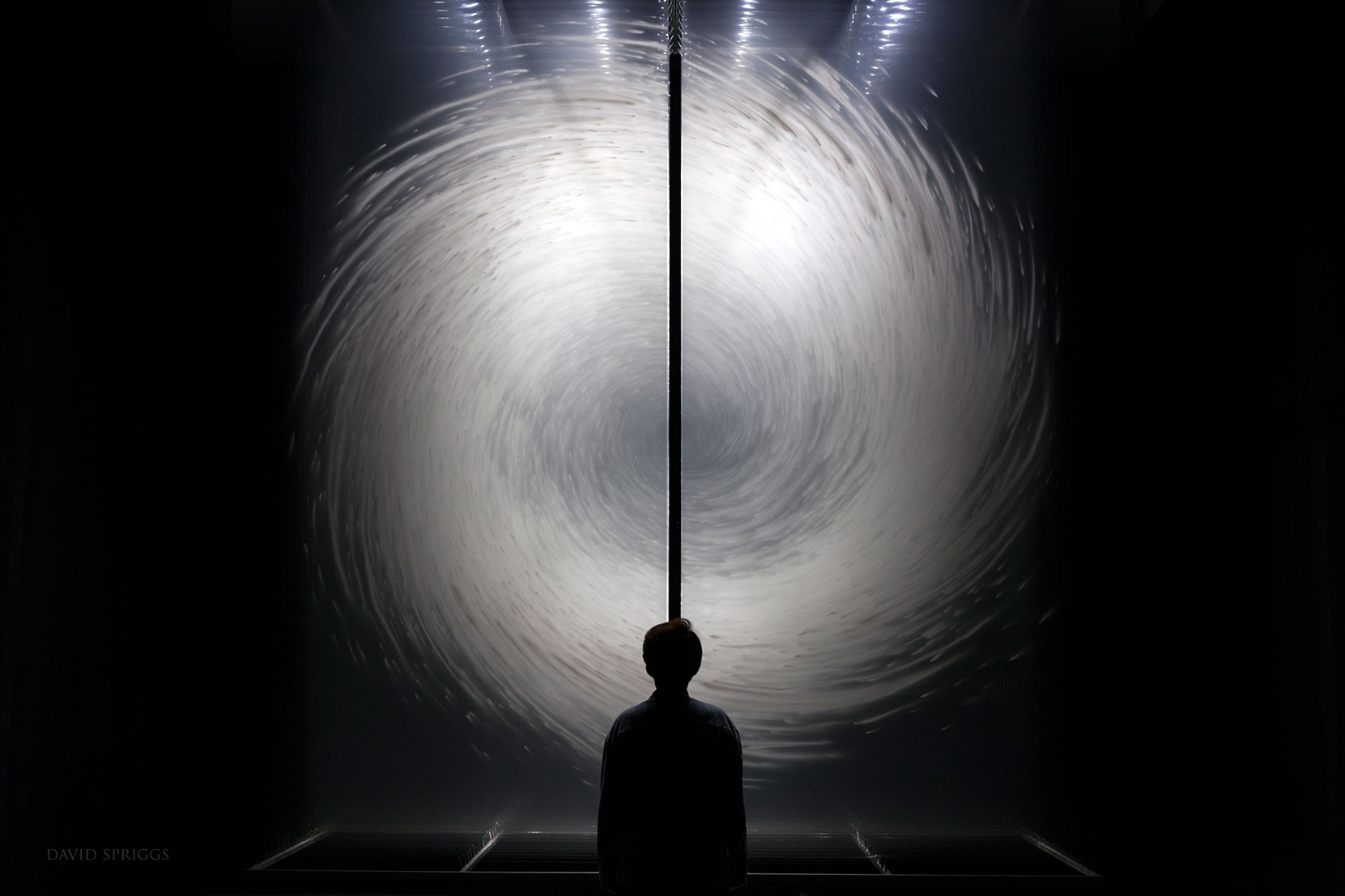
David Spriggs, Gravity
East Bund-Mingsheng Art Wharf, Shanghai, China / Exhibition: Lost in Play II. 28 Apr. – 7 May, 2019
Size: 3.2 x 4 x 3.2 m / 125 x 158 x 125 inches
Materials: Layered painted transparencies, framework.Gravity, a monumental installation, is made from thin transparent painted sheets assembled in stratified order to create a visible structure made up of different parts.
Just like the Cubists who painted objects as seen at the same time from many angles, Spriggs also reconstructed the way we perceive and understand an image through the combination of many points of view. The mind combines these different perspectives and identifies how an object resides in space.
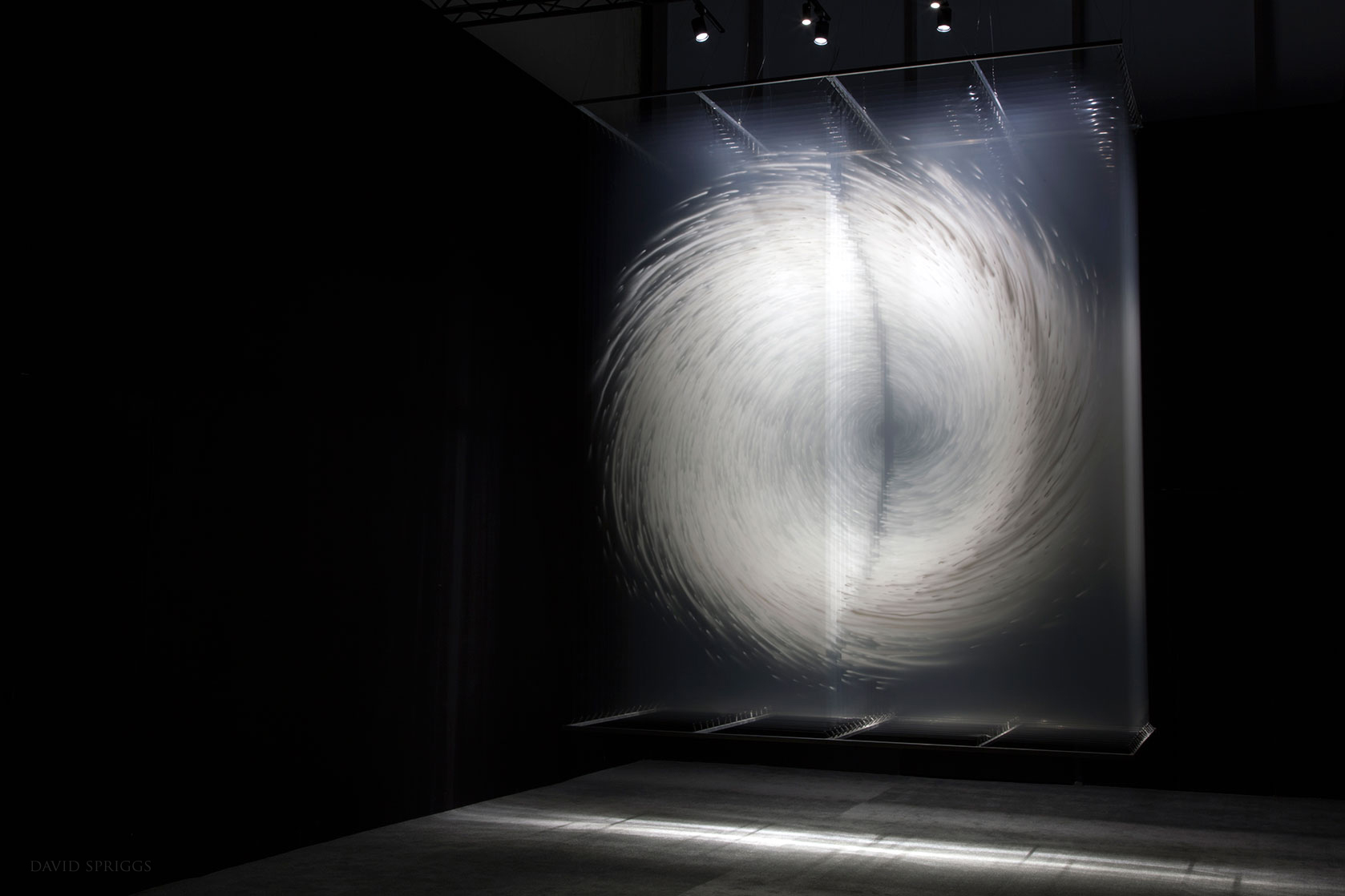
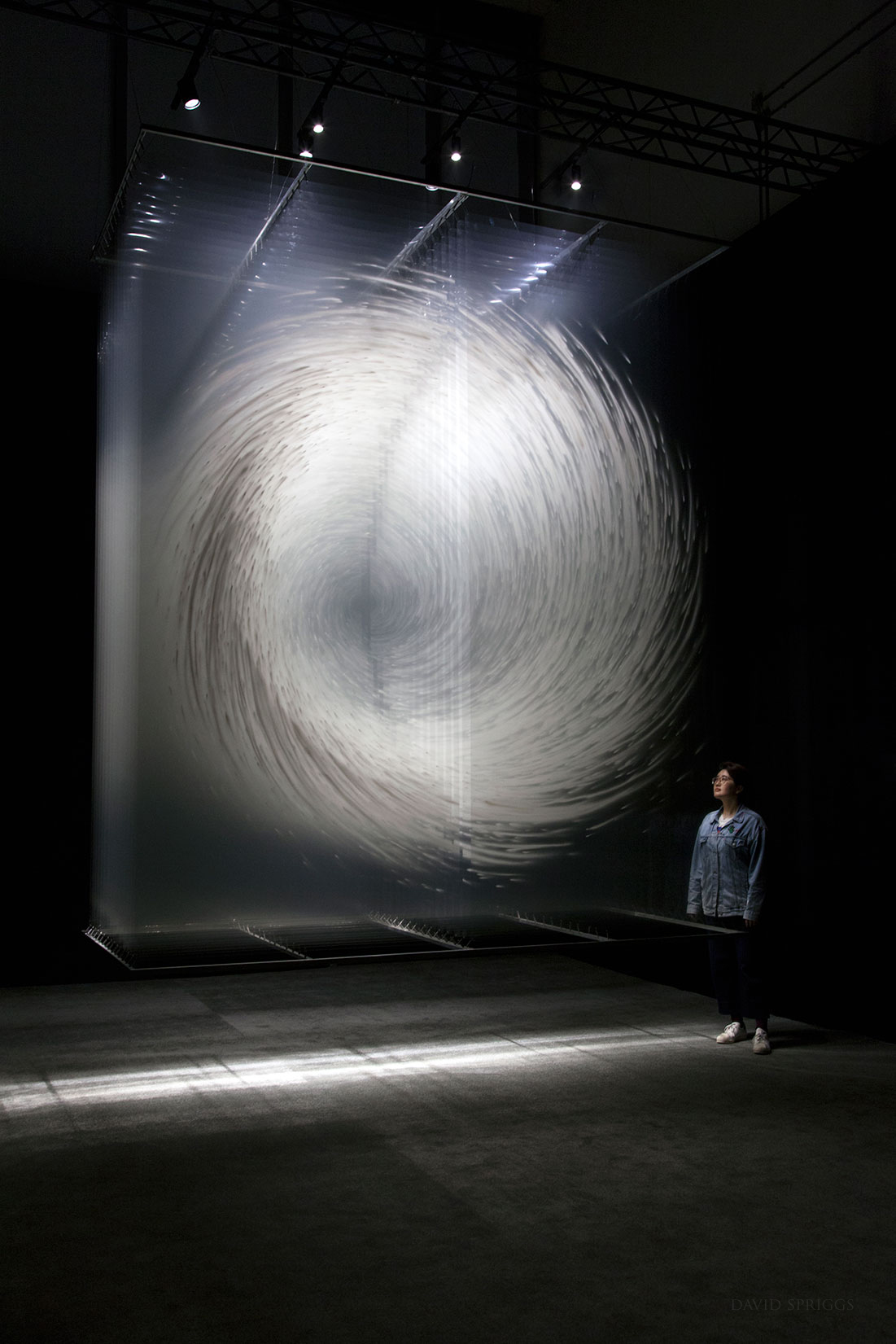
David Spriggs, Gravity
East Bund-Mingsheng Art Wharf, Shanghai, China / Exhibition: Lost in Play II. 28 Apr. – 7 May, 2019
Size: 3.2 x 4 x 3.2 m / 125 x 158 x 125 inches
Materials: Layered painted transparencies, framework.Gravity is the most recent of David Spriggs’ installations which he creates using a technique invented by himself and called ‘Stratachrome’: multiple airbrushed images layered on translucent film, on multiple plans, and displayed in illuminated or suspended plexiglass structures or in transparent, museum-style display cases. The works, each made up from 18 to 400 transparent painted and layered sheets, are both cryptic and seductive, creating an illusionism that shifts the artwork from two-dimensional into three-dimensional.

David Spriggs, Gravity
East Bund-Mingsheng Art Wharf, Shanghai, China / Exhibition: Lost in Play II. 28 Apr. – 7 May, 2019
Size: 3.2 x 4 x 3.2 m / 125 x 158 x 125 inches
Materials: Layered painted transparencies, framework.The technique, created by Spriggs in 1999, stems from the artist’s consideration of painting not on a flat surface but through a three-dimensional space. The artist was also looking for a way to use transparency not only as a property of light but as a medium itself. These considerations led him to carry out this stratification process and to what he calls the ‘perspective of the layers’. This perspective, in a sort of overturning of linear optics, where the illusion of depth is created by a vanishing point, is instead produced by placing several planes of the image in the space that collectively give the idea of depth. In this way, the viewer becomes an active part of the artwork and the real vanishing point of the images that now can be seen in infinite ways.
Spriggs’s research evolves analyzing scientific phenomena related to perception, space-time and movement, color, visual systems and surveillance, strategies and symbols of power and the thresholds of form and sensation.
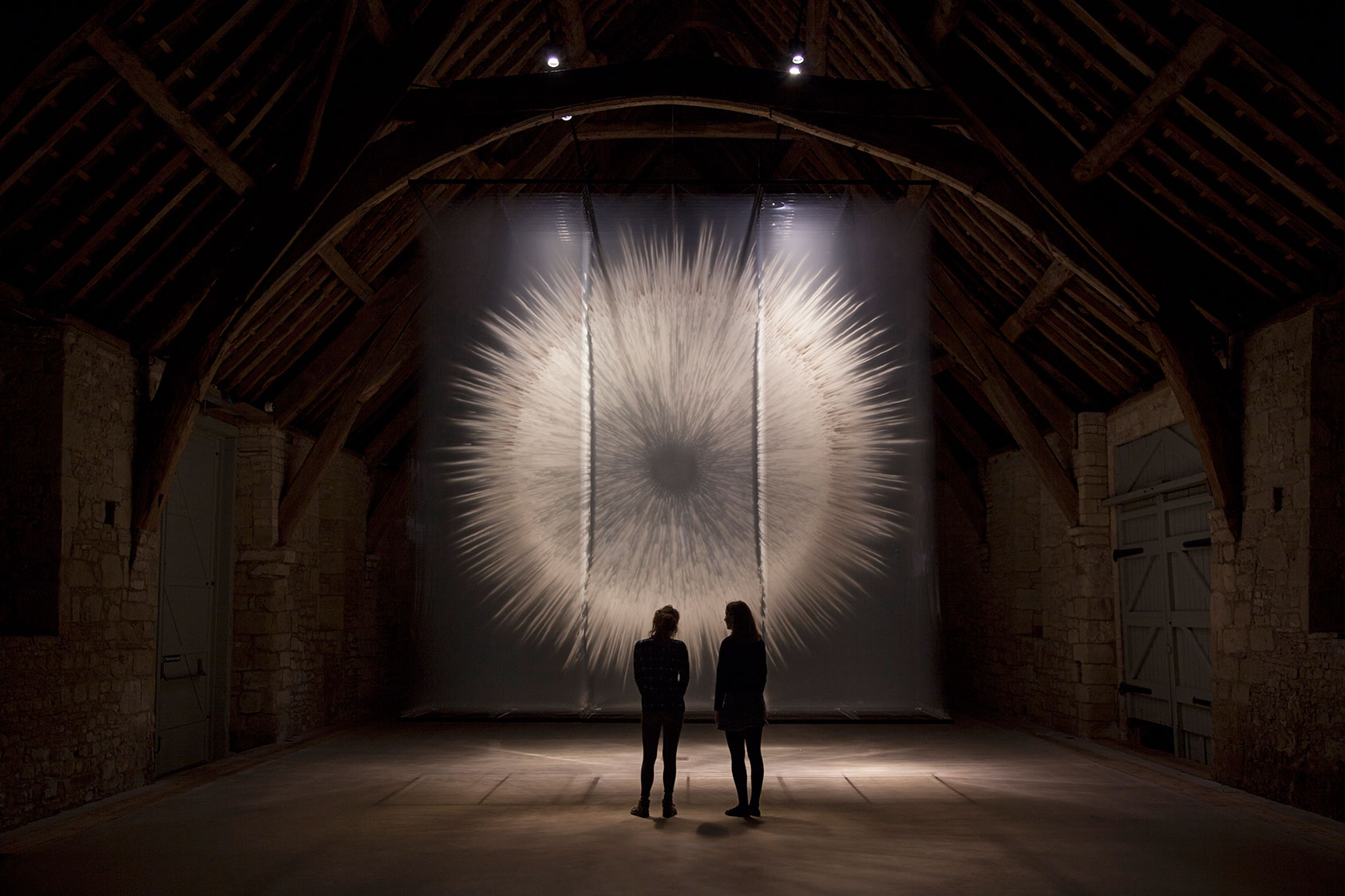
David Spriggs, Vision II, 2017
Messums Wiltshire, England, U.K.
Size: 5 x 2 x 5 metres / 16 x 6 x 16 ft
Materials: Painted layered transparent sheetsVision is a series consisting of large and small installations made in 2010 and 2019 and also exhibited at the Chroniques Biennale, Marseille, France and at the Sharjah Art Museum, Sharjah, UAE and at the Espace Virtuel, Sagunay, Quebec, Canada and in 2017 for Messums Wiltshire, England, UK. Simply positioning white airbrushed transparent layers, the artist constructs the image of an implosion or an explosion. The artwork is a real focus on the modality of perception and on how an event or the constitution of an experience made of space and time and its own understanding are created by the meeting of bodies in motion.


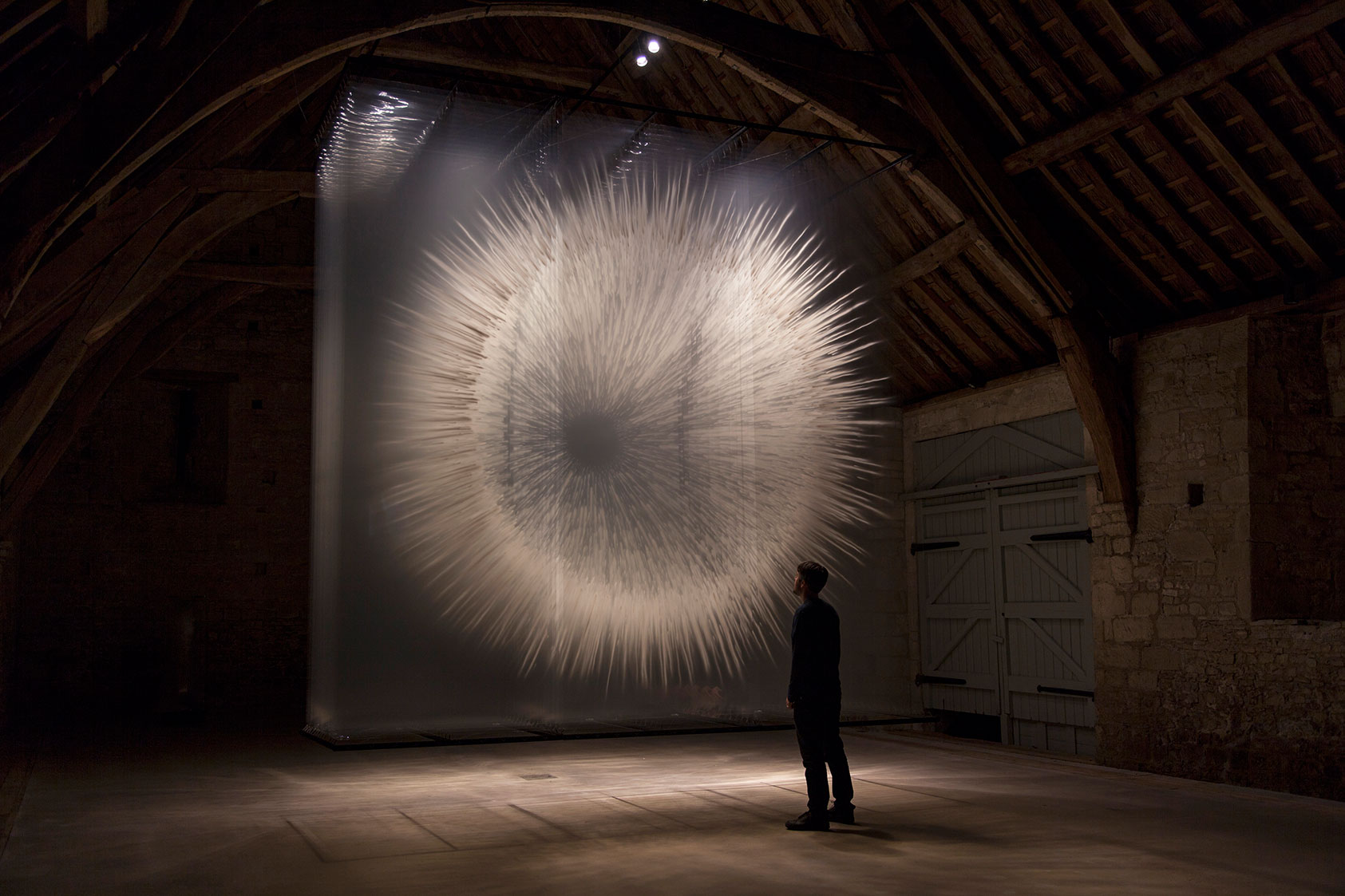
David Spriggs, Vision II, 2017
Messums Wiltshire, England, U.K.
Size: 5 x 2 x 5 metres / 16 x 6 x 16 ft
Materials: Painted layered transparent sheetsThe circular navigation of the spectator around Spriggs’ art, who walks around the work to understand its three-dimensional nature reproduces the movement around a central axis during the perception itself. In this way the viewer and his vision activate the work in a unique, individual and multiple way at the same time.
Also in the series In Utero (2001) and In Utero II (2019) in which the layers of transparent and painted sheets reproduce the image of a newborn before birth in a case, Spriggs tackles the theme of artistic experience as a fundamental and regenerative event. As in Origins (2018), the three-dimensional images stored in display cases recall an ancient sculpture, DNA and an oblong crack that resembles a black hole.
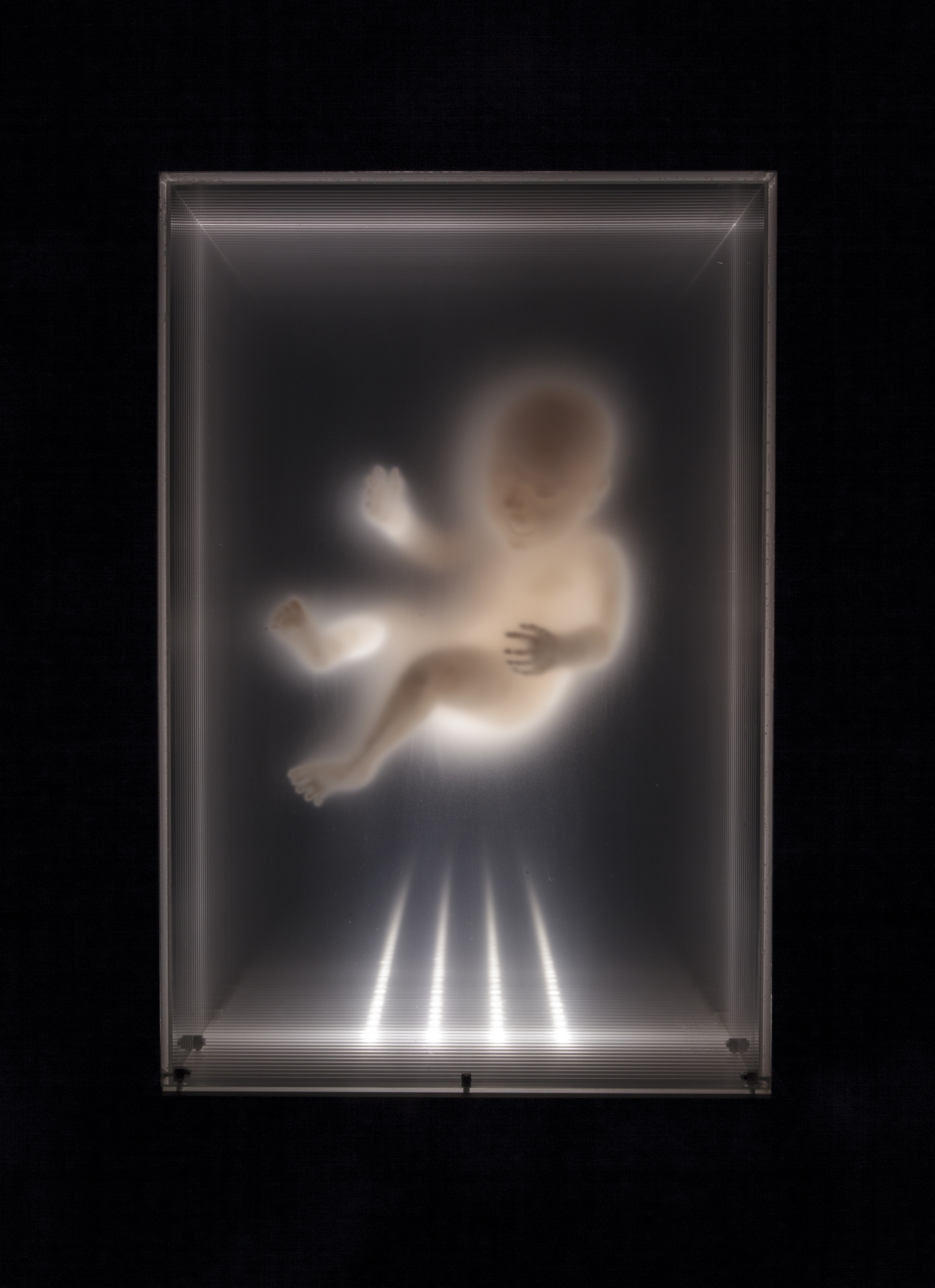

David Spriggs, In Utero II
Collection: Private, 2019
Size: 61 x 46 x 91 cm / 24 x 18 x 36 inches
Materials: Acrylic on layered transparent sheets, display caseScience, art and philosophy are intertwined in Spriggs’ research in a complex way. The artist looks at the scientific progress and research on the nature of time and space and in particular the research done at CERN, reflecting on Jean Baudrillard’s ideas on simulation, on Paul Virilio’s notions on how technology collapses space and on futurist concepts of boundless form. Other references in his practice are the ‘Light and Space’ artists of the 1960s and James Turrell, Anish Kapoor and Ollafur Elliasson.
Spriggs’ immersive installations evoke events of ontological and cosmological proportions such as the Big Bang. Moving around the work, the viewer activates the intuition that is continually altered; in fact, the installation is composed on the front and decomposed on the sides in order to raise a question in the viewer: what is actually real, the shape of a thing or only the individual images that compose it?
The artist is interested in the limits of appearance and its power both as a symbol and as a force. For example, explosions are interesting for Spriggs because they represent a state of rapid transformation, in which the shape of an object can no longer be predefined, as in the installation Axis of Power, exhibited at the Sharjah Art Museum, during the Sharjah Biennial 9, in 2009; the piece of art imitates a cyclone that seems to have been captured and immobilized in the boundaries of the exhibition space, with the main intent of focusing on the relationship between mankind and nature and the illusory sense of power we believe we have over it.
The 3D form de-materializes on the sides of the work and materializes again from another frontal perspective. In fact, for the artist it is essential that the work is perceived in motion, almost in a kinematic way, and that the subject is conceptually linked to the process and the medium.
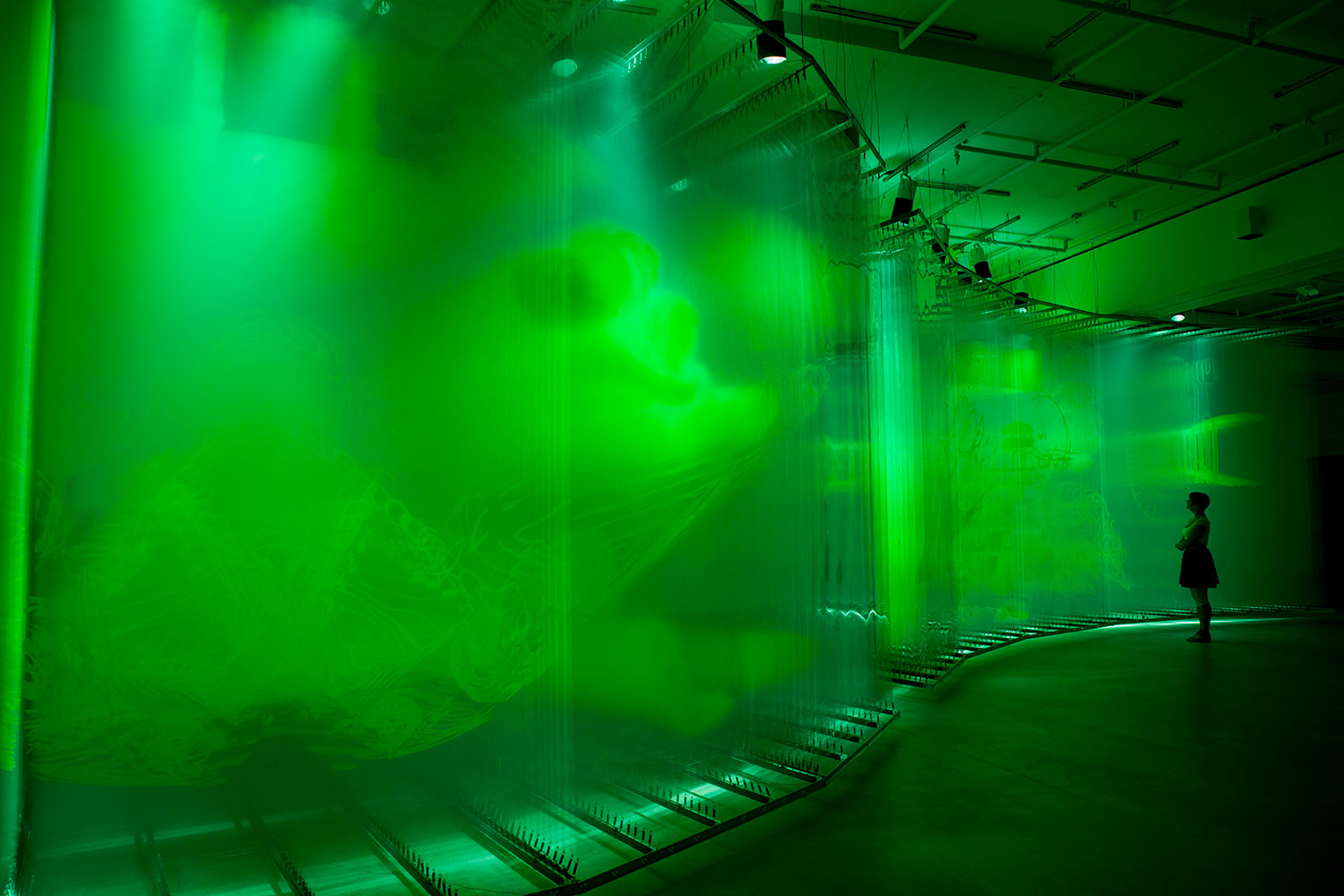



David Spriggs, Stratachrome Green, 2010
Galerie de l’UQAM, Montreal
Size: 1524 x 213 x 366 cm / 600 X 84 x 144 inches
Materials: Chroma-key green paint on layered transparenciesThe Stratachrome series is oriented towards reflecting on the very modalities of making art in a series of installations in profound dialogue with the exhibition space. Stratachrome Green, created during a residency at the Galerie de UQAM in Montréal in 2010, is a huge installation that splits the exhibition space in two sides, one is the space of movement and interaction for the spectator and the other is a wall of Chroma-key green painted transparent foils – the same green used for digital editing. The work is part of a series in which the artist explores the symbolic, historical and perceptive elements of color.
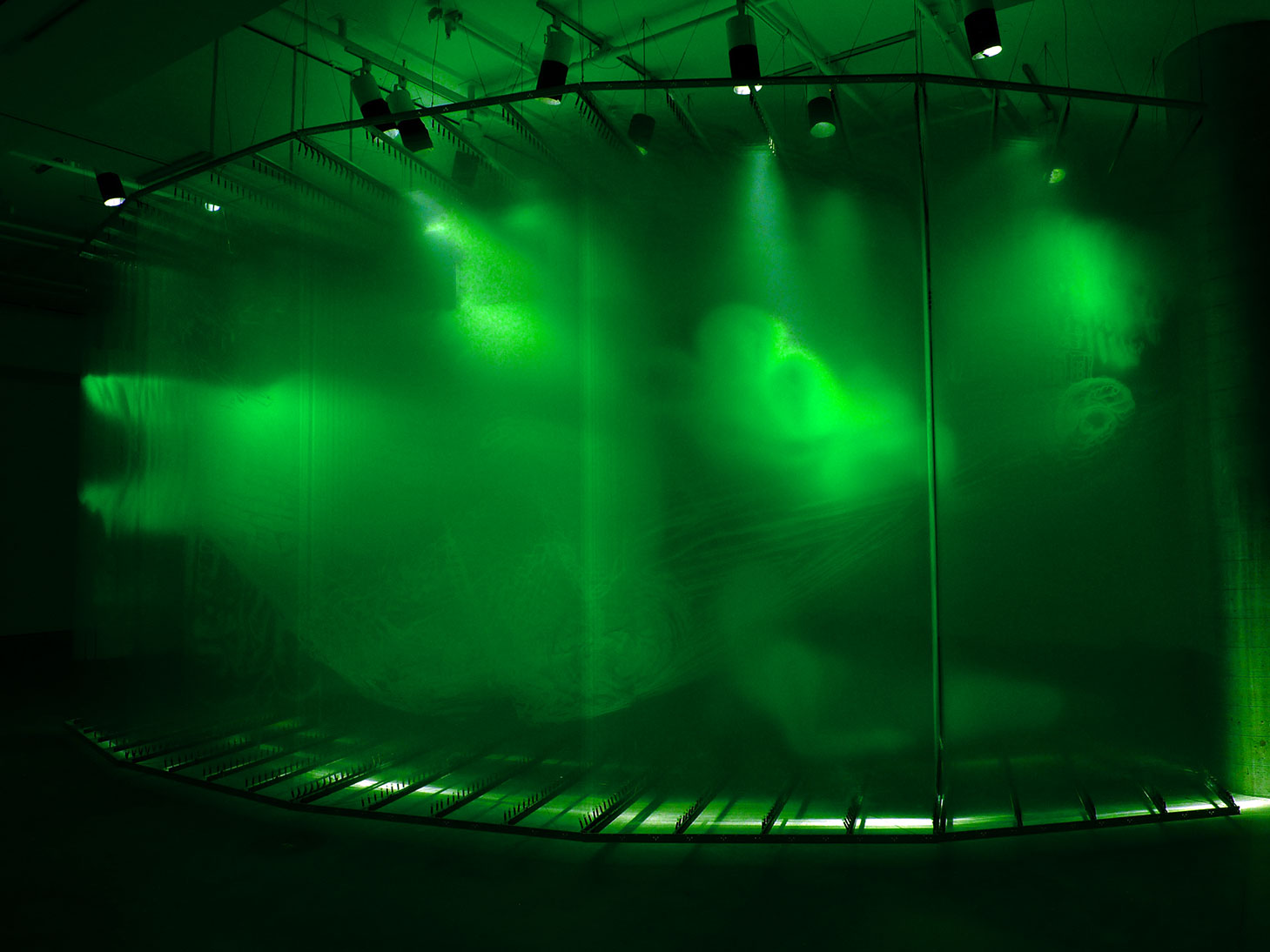
David Spriggs, Stratachrome Green, 2010
Galerie de l’UQAM, Montreal
Size: 1524 x 213 x 366 cm / 600 X 84 x 144 inches
Materials: Chroma-key green paint on layered transparenciesThe installation overwhelms the viewer in a green, almost oppressive wave. Color in this case represents the feeling of pressure that comes from the everyday media overexposure. Looking carefully into the sea of color one can detect some figures. Green becomes the substitution space in which the viewer projects himself.
The sinuous shape of the installation in the space forces the visito to follow a predefined path through the room and it is necessary to give a sculptural presence to the work from which the different symbols emerge within the work itself and its meaning which is strongly linked to the images that can be seen in the color and that are taken from new media, from personal images, news stories, etc…
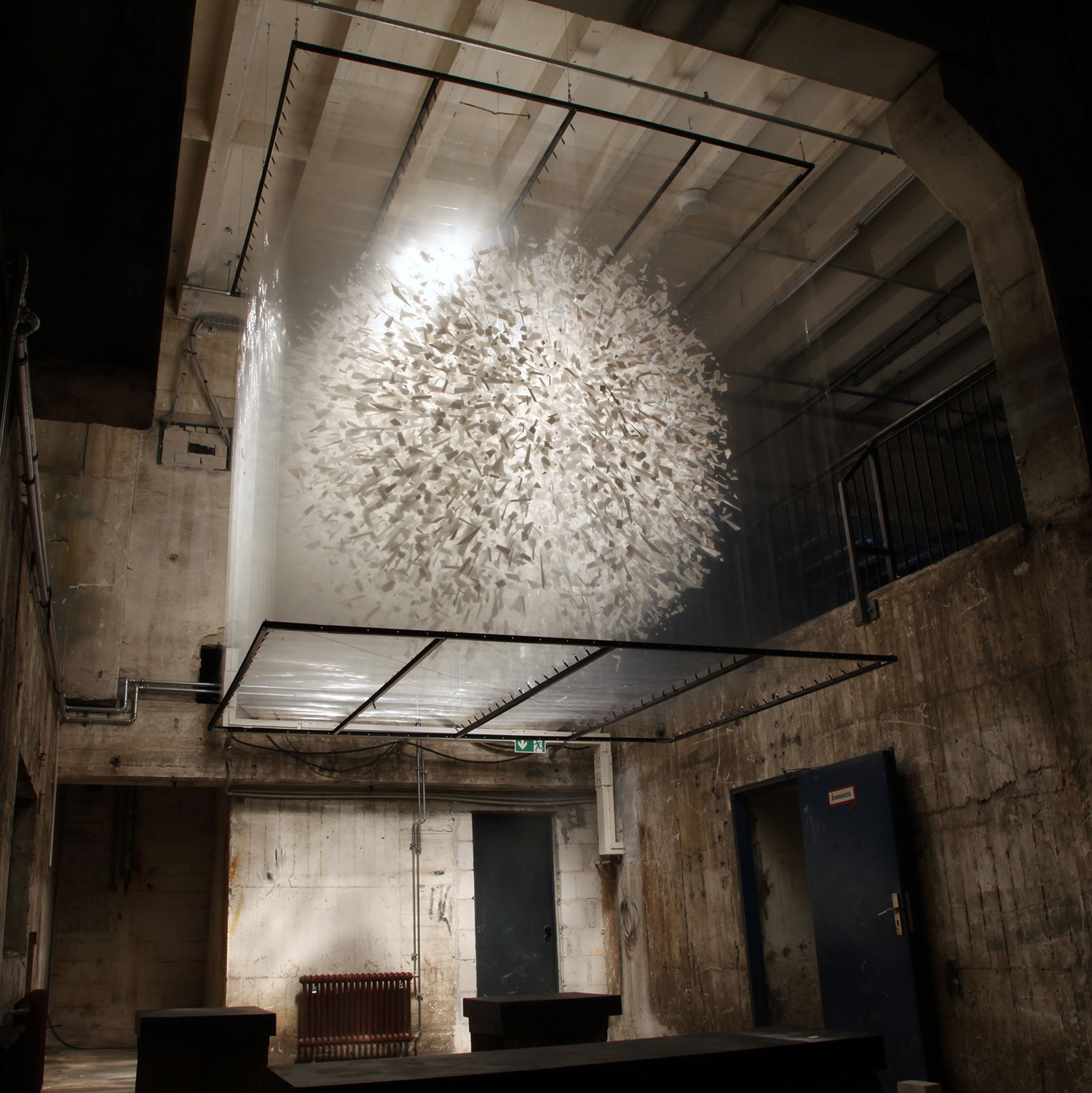
David Spriggs, Divided Power, 2017
Exhibited: Kraftwerk Berlin, Berlin Atonal, Germany
Size: 3.2 x 3.2 x 3 m / 10.5 x 10.5 x 10 ft
Materials: Layered painted transparencies, metal frameworkDavid Spriggs lives and works in Vancouver, BC in Canada, but was born in 1978 in Manchester, England. He holds a Master of Fine Arts from Concordia University, Montreal, and a Bachelor of Fine Arts from Emily Carr University in Vancouver. He has undertaken residencies at Central St. Martin’s College of Art in London, England (1999) and at Bauhaus University in Weimar, Germany (2006). He has exhibited internationally in galleries and museums such as Messums Wilthsire in the UK, Arsenal Montreal in Canada, Prague Biennial 5 in the Czech Republic, Louis Vuitton Gallery in Macau and Sharjah Biennal 9 in the United Arab Emirates. His work can be found in many prestigious collections such as the VIC Hong Kong Hotel, the Montreal Museum of Fine Arts and the National Museum of Fine Arts of Quebec.
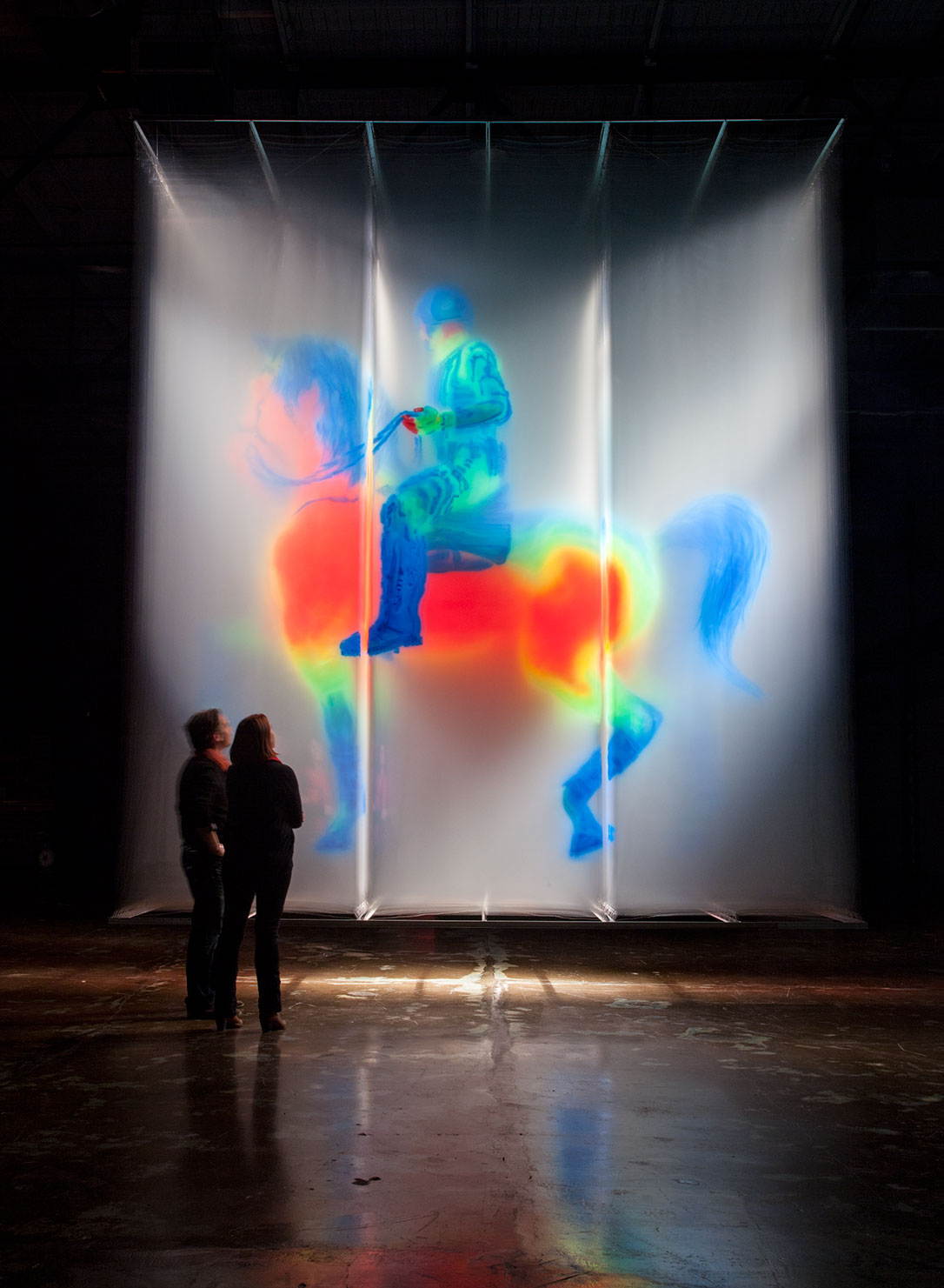
David Spriggs, Regisole, 2015
Arsenal Montreal
Size: 4.7 x 5.8 x 1.9 m / 188.5 x 72.5 x 228 inches
Materials: Painted layered transparencies, metal frameworkIn the text “Relationscapes: Movement, Art, Philosophy” (MIT Press) Erin Manning describes Spriggs’ practice as follows: “Spriggs’ work invites us to see-with what is not actually there and to move-with the constellation of what we’re beginning to see. Moving-with perception composing itself, we experience the dynamics of an object becoming spacetime. We no longer simply observe – we are moved by the experience of watching, and we move with it. We note the contours but feel the colors. We see the lines but feel the rhythm. We see-with the becoming-work. This is the activity of plastic dynamism expressing itself through the emergence of a body-image constellation.”

David Spriggs, Zenith, 2020
On permanent display at Queen’s Marque, Halifax, Nova Scotia, Canada.
Size: 381 x 185 x 185 cm / 150 x 73 x 73 inches
Materials: Acrylic on layered plexiglass in LED lit plexiglass display caseManning considers Spriggs’ work within a broad artistic movement in which relationships and encounters must be considered in terms of space and time. This interpretation that is linked to Bergson, Deleuze, Whithead conceptualizes movement as an event that creates time and space, in opposition to a pre-established situation. As the French philosopher Gilles Deleuze wrote in Difference and Repetition “Do not count upon thought to ensure the relative necessity of what it thinks. Rather, count upon the contingency of an encounter with that which forces thought to rise up and educate the absolute necessity of an act of thought or a passion to think.” Manning calls “Relationscape” this topological experience of the perception of non-representative, non-narrative and non-illustrative works of art.
David Spriggs’ sculptures invite the viewer to move within the space and to look through the fragile labyrinth in which the moving body creates the space that surrounds it. A similar process occurs in futurism, Manning explains: “This is not an easy task. Following Boccioni’s lead, David Spriggs makes sculpture dynamic, creating a relational environment. What his work proposes is that we create a movement – with that can become an emergence – of an animate form. This play with emergence is an inventive pact between art and participants. It proposes a relation without telling us in advance how to move”.


David Spriggs, Gold, 2017
Exhibited: Woodstreet Art Galleries, Pittsburgh and Arsenal Montreal.
Size: 11 x 0.7 x 3 m / 433 x 120 x 28 inches
Materials: Painted Layered Transparencies, metal-framework and light-boxThis paradox of vision in David Spriggs’ artwork is the emergence of a form from an interplay of boundaries. We do not see the true images but only their shadows, as in a Platonic cave; this gives us the sense of an appearance of complex relationships, through different movements, different times. We see this composition and we recompose it in our mind, in our consciousness, as if we were waking up from a dream. We reorganize it for our stereoscopic view of reality. Vision is in fact a movie theater of perception, of contours that move rhythmically. Stability is just an illusion. The real challenge becomes to fix things in their perpetual oscillation, to stop the moment.

